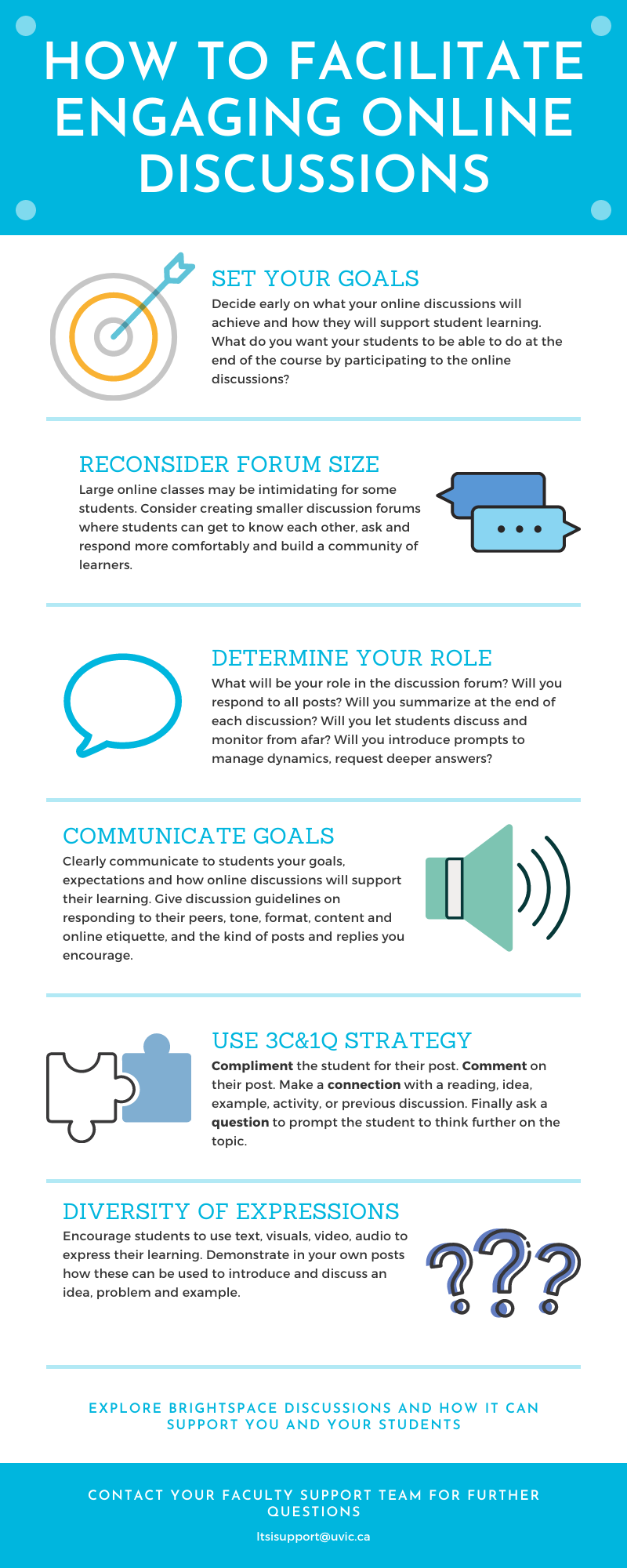Online discussions contribute to student learning, assessment and building a community of learners. Whether you teach an asynchronous or a synchronous course, online discussions would open the space for your students to ask questions, test their ideas and connect with you and other students in the course.
Asynchronous online discussions are flexible. Students can participate in the discussion when it works best for their schedule. Based on prompts, they can reflect on questions and develop and share their answers. You can use the Discussions tool in Brightspace to create forums and discussion topics, where students can engage in discussions with their peers and you.
Whichever your mode of course delivery, before posting your first question in the discussion forums, it is good practice to plan and develop a strategy for your online discussions. Here is a list of questions to consider:
- How do online discussions align with your learning outcomes?
- What will you use them for?
- How will they complement your other learning and assessment activities?
- How will they contribute to student learning?
- What are your guidelines for online discussions for students?
- What will be your role in the discussions?
Consider your class size when you are setting up discussion forums in Brightspace. You can have:
- Class discussions (all students participate): For medium to small size classes, class discussions can be spaces for posting weekly questions, prompts on readings and class material, examples and case-studies. Class-wide discussions can also function as Q&A spaces on class requirements.
- Group discussions (divide class into smaller discussion groups): In large classes, smaller groups can encourage students to share their thoughts more easily. This kind of discussion can also be helpful for group work.
- Individual reflections (each student has a discussion space that functions like a blog visible by the student and the instructor only): Students can reflect and write their thoughts on their weekly readings and class discussions and keep a “personal diary of learning”.
You can encourage students to participate in discussions based on 3C&Q model, which is a strategy developed by Jennifer Steward Mitchell to respond to online posts. It can also be a guideline for students when they are responding each other:
- Start with a Compliment to the post and highlight at least one point made by the learner.
- Comment on at least one point: be specific and feel free to agree or disagree.
- Connect an idea, process, experience or reading to the post and use details to explain the connection.
- Ask a specific and relevant question to keep the conversation going.
Additional information on using online discussions in synchronous and in-person courses:
Synchronous online discussions can take place in real time and are faster. They offer less time for deep reflection. Yet, they are helpful for clarifying and addressing questions and for teamwork. Microsoft Teams channels and chats for synchronous online discussions and can be used for communication in teamwork and projects in courses. Zoom can also be used as a platform for synchronous online discussions between the instructor and the learners or among learners working in project groups.
Similarly, in-person courses can also have online discussion forums in Brightspace as supplementary to physical classroom discussions. They can be places for sharing information and confirming course requirements among students and the instructor.
Here are some quick tips on planning and facilitating class discussions.

Resources
Simon, E. (2018, November 21, ). 10 Tips for effective online discussions. Educause Review. https://er.educause.edu/blogs/2018/11/10-tips-for-effective-online-discussions
University of Waterloo, Centre for Teaching Excellence. (2020, December 11). Online Discussions: Tips for Instructors. uwaterloo.ca/centre-for-teaching-excellence/teaching-resources/teaching-tips/alternatives-lecturing/discussions/online-discussions-tips-for-instructors.
Vonderwell, S. Liang, X. and Alderman, K. (2007). Asynchronous Discussions and Assessment in Online Learning, Journal of Research on Technology in Education, 39(3), 309–328
